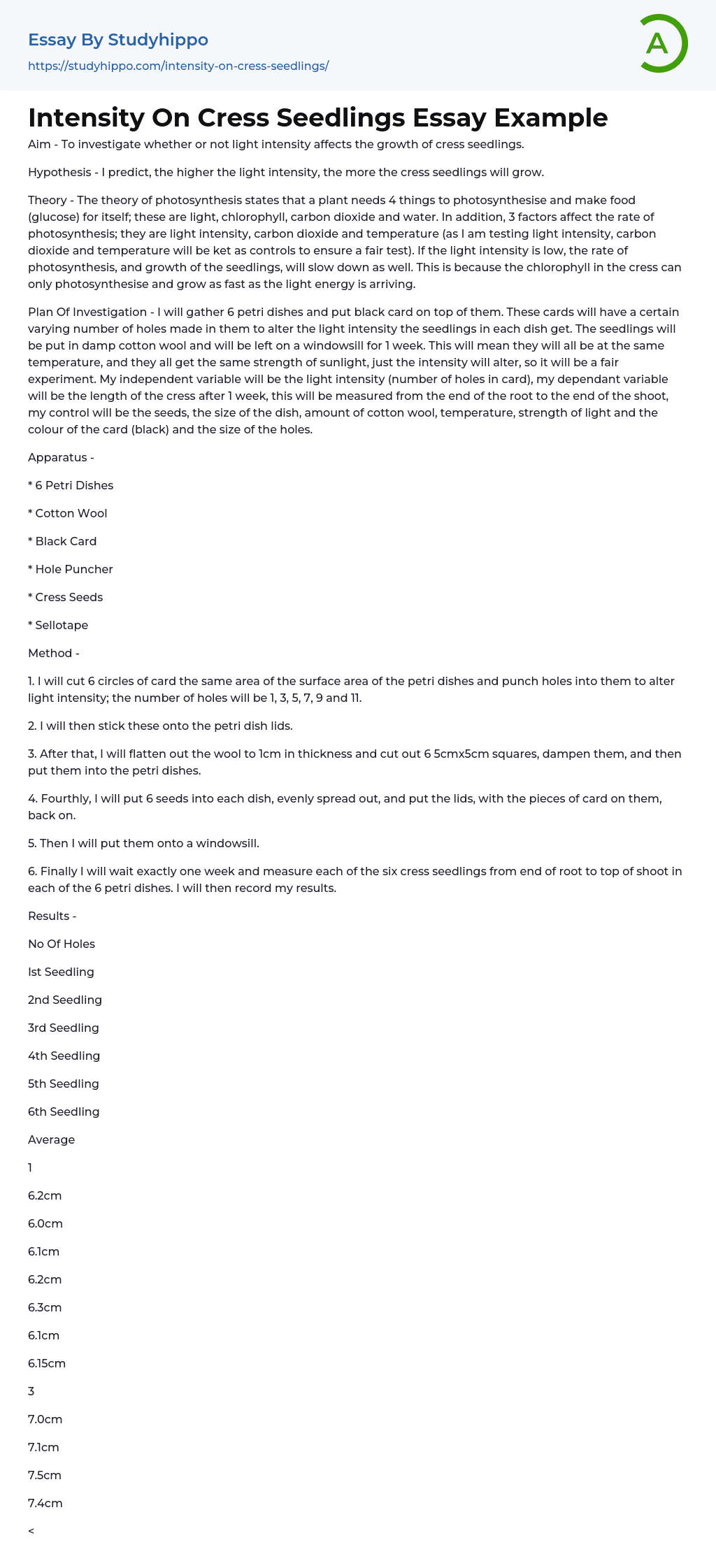Aim - To investigate whether or not light intensity affects the growth of cress seedlings.
Hypothesis - I predict, the higher the light intensity, the more the cress seedlings will grow.
Theory - The theory of photosynthesis states that a plant needs 4 things to photosynthesise and make food (glucose) for itself; these are light, chlorophyll, carbon dioxide and water. In addition, 3 factors affect the rate of photosynthesis; they are light intensity, carbon dioxide and temperature (as I am testing light intensity, carbon dioxide and temperature will be ket as controls to ensure a fair test). If the light intensity is low, the rate of photosynthesis, and growth of the seedlings, will slow down as well. This is because the chlorophyll in the cress can only photosyn
...thesise and grow as fast as the light energy is arriving.
Plan Of Investigation - I will gather 6 petri dishes and put black card on top of them. These cards will have a certain varying number of holes made in them to alter the light intensity the seedlings in each dish get. The seedlings will be put in damp cotton wool and will be left on a windowsill for 1 week. This will mean they will all be at the same temperature, and they all get the same strength of sunlight, just the intensity will alter, so it will be a fair experiment. My independent variable will be the light intensity (number of holes in card), my dependant variable will be the length of the cress after 1 week, this will be measured from the end of the root to the end of the shoot, my control will be th
seeds, the size of the dish, amount of cotton wool, temperature, strength of light and the colour of the card (black) and the size of the holes.
1. I will cut 6 circles of card the same area of the surface area of the petri dishes and punch holes into them to alter light intensity; the number of holes will be 1, 3, 5, 7, 9 and 11.
2. I will then stick these onto the petri dish lids.
3. After that, I will flatten out the wool to 1cm in thickness and cut out 6 5cmx5cm squares, dampen them, and then put them into the petri dishes.
4. Fourthly, I will put 6 seeds into each dish, evenly spread out, and put the lids, with the pieces of card on them, back on.
5. Then I will put them onto a windowsill.
6. Finally I will wait exactly one week and measure each of the six cress seedlings from end of root to top of shoot in each of the 6 petri dishes. I will then record my results.
Conclusion - I found that I was correct in my hypothesis in thinking that the more light the seedlings get, the more they will grow. This is corroborated by the positive correlation in my graph of results. This is because, as stated in the theory, the speed at which a plant makes food and grows as an effect of photosynthesis depends on the intensity of light. I observed there was only a 0.08cm difference in height between the cress seedlings averages in the petri dishes with 3 and 5 holes. This is because, a seed already has a food store, and if
the shoot cannot find sunlight it uses the food store it already has, to grow in search of sunlight. The result for the petri dish with 3 holes was the only anomalous result, all the rest were correct because I successfully blocked out any extra sunlight other than the light coming through the holes.
Evaluation - If I were to do the experiment again I would find a better way to vary light intensity and I would like to be able to somehow measure the light intensity and put it into a graph in relation to the growth of the seedlings, to see if there are any other patterns to be observed. After doing this experiment I would like to test the affect of limited carbon dioxide and varying temperature on cress seedlings.
- John Locke essays
- 9/11 essays
- A Good Teacher essays
- A Healthy Diet essays
- A Modest Proposal essays
- A&P essays
- Academic Achievement essays
- Achievement essays
- Achieving goals essays
- Admission essays
- Advantages And Disadvantages Of Internet essays
- Alcoholic drinks essays
- Ammonia essays
- Analytical essays
- Ancient Olympic Games essays
- APA essays
- Arabian Peninsula essays
- Argument essays
- Argumentative essays
- Art essays
- Atlantic Ocean essays
- Auto-ethnography essays
- Autobiography essays
- Ballad essays
- Batman essays
- Binge Eating essays
- Black Power Movement essays
- Blogger essays
- Body Mass Index essays
- Book I Want a Wife essays
- Boycott essays
- Breastfeeding essays
- Bulimia Nervosa essays
- Business essays
- Business Process essays
- Canterbury essays
- Carbonate essays
- Catalina de Erauso essays
- Cause and Effect essays
- Cesar Chavez essays
- Character Analysis essays
- Chemical Compound essays
- Chemical Element essays
- Chemical Substance essays
- Cherokee essays
- Cherry essays
- Childhood Obesity essays
- Chlorine essays
- Classification essays
- Cognitive Science essays




